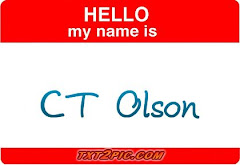Friday, September 25, 2009
Free admission to Ecotarium and Higgins tomorrow
AuburnSchools Smithsonian Magazine presents Museum Day. Enjoy free admission to many local museums on Saturday, 10/26. http://twurl.nl/sloq5r
Wednesday, September 23, 2009
Healthier school lunches
Good article here on the bill in Congress now called the Child Nutrition Act
Whole foods has a program to assist with making lunches healthier called school lunch revolution.
Link
The lunch box is an online tool to help plan healthier choices from Chef Ann Cooper (the self-named renegade lunch lady who teamed with Whole Foods).
5 tips here:
Some local programs along these lines
DrAyalaWash. Post: School Lunch Punch: The wisdom of spending more money to provide healthier meals. http://bit.ly/nDnhk
Whole foods has a program to assist with making lunches healthier called school lunch revolution.
Link
The lunch box is an online tool to help plan healthier choices from Chef Ann Cooper (the self-named renegade lunch lady who teamed with Whole Foods).
5 tips here:
Some local programs along these lines
BEDFORD Kids Cooking Green Lori Deliso 781-863-6375
BOSTON Countdown to Kindergarten Sonia N.Gómez-Banrey 617-635-6816 26 Court Street 6th FL
Boston, MA 02108
CAMBRIDGE City Sprouts Jane Hirschi 617-876-2436 25 River Street
Cambridge, MA 02139
FRAMINGHAM McAuliffe Regional Charter Public School Ben Zimmerman 847-477-4616 25 Clinton Street
Framingham, MA 02155
NEWTONVILLE John M. Barry Boys & Girls Club David Sellers
NEWTONVILLE Waltham Fields Community Farms Claire Kozower 781-899-2403
Benefit of climate legislation and other environmental acts
Business often speaks of the cost side of environmental law, what about the benefits?
This is something often ignored on the local level as well - what is the benefit of spending money on open space or clean water for our town. They tend to be longer term strategic interests.
Link
This is something often ignored on the local level as well - what is the benefit of spending money on open space or clean water for our town. They tend to be longer term strategic interests.
Link
So, given that the Waxman-Markey bill would curb emissions over the next 40 years, it’s a pretty simple job to tally up the potential benefits: about $1.5 trillion on the middle-of-the-road estimate. The benefits could be as low as $382 billion or as high as $5.2 trillion, depending on how you fiddle with the numbers.
Since Waxman-Markey is meant to cost about $660 billion, that means the bill provides $2.27 in benefits for every dollar spent, the brief concludes. That doesn’t include extra benefits—cleaner air from a cleaned-up power sector, for instance. And it suggests that even tougher greenhouse-gas targets in the Senate version of the bill would make an even more compelling economic argument.
Wednesday, September 2, 2009
Some goals for a school in the new age
Got this through the FCC's blog on broadband via a whitehouse tweet
whitehouseFCC Chairman Julius Genachowski blogs an update on the National Broadband Plan http://bit.ly/zMC5J
http://blog.broadband.gov/?cat=36
http://blog.broadband.gov/?p=129#comments
whitehouseFCC Chairman Julius Genachowski blogs an update on the National Broadband Plan http://bit.ly/zMC5J
http://blog.broadband.gov/?cat=36
Later that afternoon, I participated in a panel about education and broadband. I could not stop thinking that every high school student in the U.S. should be able to watch the Feynman lectures on physics online (requires Silverlight 3.0) from their home as many times as needed until they truly understand why physics and math are both important and cool. Every parent should be able to look up their child’s homework assignments for next week on the web. Every teacher should be able to access the best pedagogic content in the world to meet their student’s needs. And ours kids must be able to go to school without carrying bags weighing 20lbs. How to get there is a great challenge, as broadband is actually just a small piece of this puzzle. We will be looking at a different facet of broadband and education Wednesday afternoon in a workshop on broadband’s impact on job training programs
http://blog.broadband.gov/?p=129#comments
Access to Feynman is a moving and a great example. That application needs low delay/latecy characteristics, something say 6Mb Mobile Broadband service will fail to support because of the delay characteristics.
Here http://bbbritain.co.uk/ubs.aspx I listed a set of applications to be support a minimum service.
Tuesday, September 1, 2009
Good tweet on what local government can do to combat obesity
from CR ...
Ways your local government can help prevent childhood obesity http://bit.ly/39nzJ
Ways your local government can help prevent childhood obesity http://bit.ly/39nzJ
* Zoning restrictions on fast-food restaurants near schools
* Taxes on high-calorie, low-nutrient foods and drinks
* Increasing access to healthy foods in underserved neighborhoods through supermarkets, grocery stores, and convenience stores
* Eliminating outdoor ads for high-calorie, low-nutrient foods and drinks near schools
* Requiring calorie and other nutritional information on restaurant menus
* Rerouting buses or developing other transportation strategies that ensure people can get to grocery stores
* Collaborating with schools to develop and implement a "Safe Routes to School program" to increase the number of children safely walking and bicycling to schools.
* Building and maintaining parks and playgrounds that are safe and in close proximity to residential areas.
* Regulating play space, physical equipment, and duration of play in preschool, after-school, and child-care programs.
Subscribe to:
Posts (Atom)


